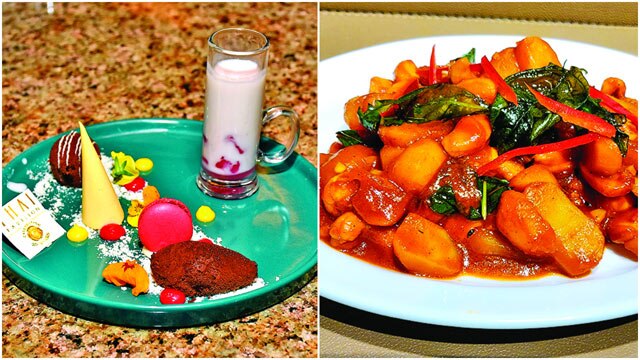
Think Thai cuisine and the taste buds quickly recall pungent, but tantalising flavours. Noodles in a spicy peanut sauce, hot and sour Tom Yum Goong soup or a popular favourite – Pad thai noodles.
Affiliated with street food, Thai cuisine is generally a pleasant eating experience, occasionally catering to those with ambitious palates with crispy ants, fried roaches or even snakes. But that’s in the realm of street food.
A lesser spoken aspect is the royal side to Thai cuisine, where kings and nobles were the original foodies of that time, trying out new flavours, experimenting with textures and tastes.
Mumbai’s Thai Pavilion’s open kitchen recently introduced us to a sliver of this, to celebrate its 25th anniversary. Making the introductions was Chef Nooror Somany of Blue Elephant, whipping up Chor Muang – a tasty bluish green Thai flower-shaped dumpling that comes with a salmon and sweet turnip filling. “It’s what we served the royals. These recipes were written during the rule of King Rama II of Siam,” she begins. “Thai food has a lot of history and that includes the local street food as well. The same food became really popular during King Rama V, because he loved to cook and eat,” she says, chuckling. Somany pinched the amethyst-toned dumplings all around to resemble eaves, curvy-edged rooftops particularly seen in the Orient. Edges of the roof were curved to appear royal and ward off evil. Speaking of the blue dough, Somany adds, “During King Rama II’s rule, the Chinese came to Thailand and they brought the flour used in the dough for dumplings. The palaces started to make the dumplings but presented them in a flower shape to represent royalty.”
Like Chor Muang, the restaurant serves a host of dishes that date back to the time of the royals. There’s the Golden Flower – a flower-shaped egg yolk cooked in syrup from the reign of Somdet Phra Narai Maharat during the Ayutthaya Kingdom. There’s also the Singh Hon Curry, which is tofu cooked in coconut milk, cinnamon, turmeric and organic herbs. “This dish was also served to King Rama II and the spices came from Sri Lanka,” says Somany.
For the most part what makes these dishes fit to serve kings are their appearances. “These dishes need to be presented in a certain way. They [Thailand royalty] eat with their eyes first,” says Somany who claims to have cooked for the royals herself.

[(Right) The special Thai Dessert; Stir-fried water chestnuts and cashew nuts in Thai paste]
At the restaurant, my eyes wandered to the non-vegetarian side of the menu that offered fried lamb and soft shell crab. Little did I notice the water chestnuts making their way into each course. Much like the royal side to Thai, this vegetable has its subtle presence in the local cuisine. At first glance, the water chestnut is far from anything appealing, but one bite into its crisp, juicy texture (resembling apples) could sideline the fried lamb.
“It’s a key ingredient in Thailand,” says Chef Uddipan Chakravarthy, who fondly speaks of the vegetable and ensures none of it is wasted. So shavings of the water chestnut were seen in the rice tartlet entree. It was also stir fried with cashew nuts and served in a Thai paste for the main course. And there were traces of the delectable veggie cut in circular shapes and dipped in rose water to attract a pink colour and served with coconut milk for dessert.
Though Thai Pavilion has just three dishes that include the water chestnut, there are numerous others that witness this subtle intrusion. “It’s used in Pad Thai, in Thai curries, desserts... It’s even relished with lychees or steamed rice,” adds Chakravarthy.